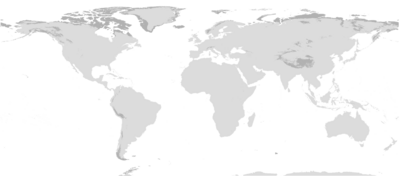Tundra climate
This article needs additional citations for verification. (June 2022) |

The tundra climate is a polar climate sub-type located in high latitudes and high mountains. It is classified as ET according to Köppen climate classification. It is a climate which at least one month has an average temperature high enough to melt snow (0 °C (32 °F)), but no month with an average temperature in excess of 10 °C (50 °F).[1]
It is important to note the existence of another variation called alpine tundra. Alpine tundra refers to the tundra environment found at high altitudes, usually above the treeline. It is mostly located at high elevation montane grasslands and shrublands, including the puna and páramo in South America, subalpine heath in New Guinea and East Africa, steppes of the Tibetan plateaus, as well as other similar subalpine habitats around the world.[2] This type of tundra climate exhibits similar characteristics to its polar counterpart but is specifically associated with elevated landscapes.
Despite the potential diversity of climates in the ET category involving precipitation, extreme temperatures, and relative wet and dry seasons, this category is rarely subdivided. Rainfall and snowfall are generally slight due to the low vapor pressure of water in the chilly atmosphere, but as a rule potential evapotranspiration is extremely low, allowing soggy terrain of swamps and bogs even in places that get precipitation typical of deserts of lower and middle latitudes. The amount of native tundra biomass depends more on the local temperature than the amount of precipitation.[1]
There also exists an oceanic variety of the tundra climate with cool to mild winters (the coldest month averaging around 0°C) which borders the subpolar climate (Cfc) and is found in parts of Iceland, the Aleutian Islands and most predominantly on subantarctic islands.
See also
References
- ^ a b "Tundra climate". Encyclopædia Britannica. 31 July 2017.
- ^
 This article incorporates text available under the CC BY-SA 3.0 license. World Wide Fund for Nature. "Montane Grasslands and Shrubland Ecoregions". Archived from the original on 2011-04-01. Retrieved 2023-06-06.
This article incorporates text available under the CC BY-SA 3.0 license. World Wide Fund for Nature. "Montane Grasslands and Shrubland Ecoregions". Archived from the original on 2011-04-01. Retrieved 2023-06-06.
- "Tundra". Earth Observatory. NASA.
- "The tundra biome". UC Museum of Paleontology. University of California, Berkeley.
